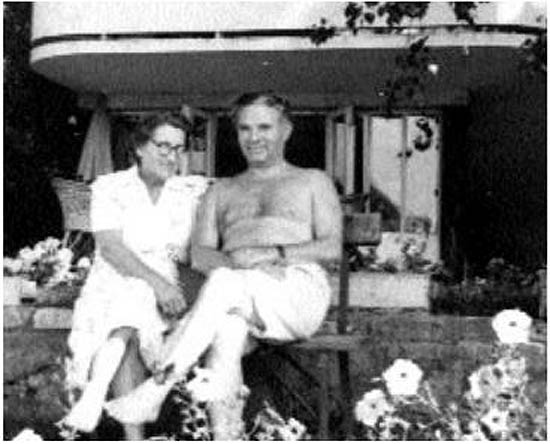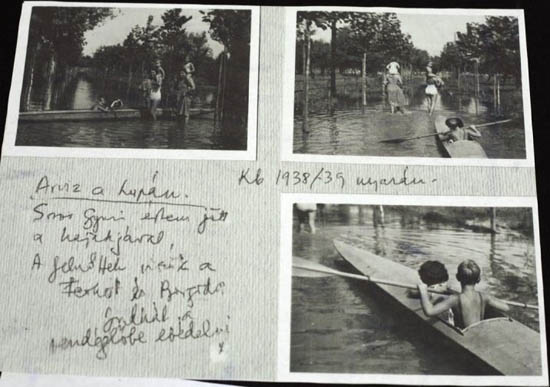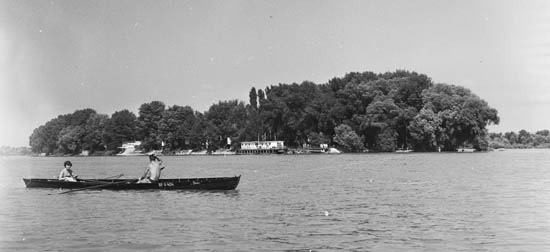
| Our partner blog, the Dunai Szigetek / Donauinseln is eight years old today. We celebrate the birthday with a post of the blog’s author, Dániel Szávoszt-Vass, specifically written for Poemas del río Wang. |
In Luppa Island near Budakalász, parceled between the two world wars, a unique architectural environment and micro-society emerged. In 1932, just a year after the inauguration of the experimental housing estate in Pasarét in the north of Budapest, the other Bauhaus reserve of Hungary was established here, on a one-street island in the Danube. Military officers, manufacturers, lawyers, architects, artists bought land here and spent their summer holidays in their cottages standing on high “legs”. The lawyer Tivadar Soros (originally Schwartz), father of George Soros, also bought here a cottage in the name of his wife.
Until it was parcelled, Lupa or Luppa Island was just a boulder with some lonely trees and a shepherd’s hut. Perhaps this is why it was called Mészáros (Butcher) Island. Administratively it belongs to Budakalász, but it is almost completely isolated from it by the Danube. It can be approached only across the water. It is completely covered during larger floods, so it is no accident that the airy ground floors of the cottages are primarily used for storage. During flooding, probably the inhabitants of Luppa Island are the most assiduous visitors of water level reporting websites.

In summer, Luppa Island is full of life. The surrounding Danube roils with motorboats, tugboats and oher hand-driven watercraft. On the shore, clouds of cyclists are wafted by the wind to the north, Szentendre and the Danube bend. Meanwhile, Luppa Island, nestling in the shadow of mighty plane trees, is filled with the noise of tinkering. The owners repair the damage from the spring flood, clear off driftwood, in order to prepare everything to receive family members and their guests during the summer. Not many unknown people visit the island. A few canoes stop here for a beer or for lunch, but they usually do not stay there for a night. They also feel that this is still a closed community.

A study by Bálint Ablonczy reports about the beginnings of the settlement in the island:
“On the 6-hectare island, 160 plots were parceled, each between 2700 and 8000 square meters. At the beginning, not all plots were sold, and the new owners built houses only on a few of them. (Some owners bought more than one neighboring plots.) The average plot size varied between 3000 and 4000 square meters, for which the buyers paid between 1200 and 1800 pengő. If they wanted so, they could also pay in installments. [...]
By 1941, 33 houses were built in the island. Their number rose only by two by 1947, but five of them were in ruins – not so much because of the destruction of the war, but due to the overwhelmingly devastating ice flood at the turn of 1944 and 1945. The first cottages already stood in 1934, and at the end of that year, the Budakalász-Lupasziget Baths Association was established in Fészek Club.”The 33 cottages built before 1941 also included the holiday house of the Soros family, designed by Endre and György Farkas. The Budapest lawyer Tivadar Soros was born in Nyírbakta, to a family of ten children, and later died in New York. He was a famous Esperanto enthusiast. He had learned the language during WWI in Russian captivity. He also wrote in this language his memoirs, which contain many references to the summers spent in Luppa Island. Just like many other cottage owners, he bought the plot in the name of his wife. The Bauhaus-style Soros Cottage was completed in 1935. His designer, György Farkas had been acquainted with Tivadar Soros in Berlin, and later he married Klára, the sister of Soros’ wife Erzsébet. The two tennis courts in the island were established on the proposal of Tivadar Soros. The cottage was owned by the family until 1944. Then Soros donated it to a certain Hászka, in whose villa in Buda he was hiding during the Nazi occupation and the siege of Budapest, together with the famous architect Lajos Kozma, who was also a cottage owner in Luppa Island.

George Soros, born in 1930, also often spent the summer vacation in Luppa Island. It was not only a holiday, but also “work”. He established a newspaper, of which he was the author, editor, reporter and distributor. The periodical was called the Luppa News. And in times of flood, he sat in a kayak, and slalomed between the recently planted plane line, as evidenced by the following images.
“– Gyuri! – I tell him strictly. – What does this mean? What do you want here with this big money?
A light flashes in the two angelic whimsical eyes.
– I brought it to the Finns. They are fighting a freedom fight now. Daddy said.
I put Gyuri under gritty cross-questions. He patiently replies to the questioning. The money belongs to him. No, he did not get it from his dad. Neither from his mom. It is his. He earned it. How? In the summer. Because in the summer he is a newspaper editor, publisher and paperboy in one. They spend the holidays on Luppa Island. And then he composes a newspaper, the «Luppa News». He is the only journalist, editor, reporter and paperboy of the news. As if he is a chamber member? No, no. In any case, the newspaper was mainly bought by the adults, since children do not have money. He, however, can earn money in this way. Until now he kept the two banknotes, put aside for Christmas, in a plaster money box.
One can even see the plaster dust on the crumpled banknotes. He broke the money box, and brought the money. To the Finns.
Gyuri Soros, a fourth elementist, who had five B marks in his recent certificate, this apple-faced smiling little guest, the all-in-one editor-in-chief of Luppa News, the golden-hearted little Hungarian calms down, when we take over his gift. Then he closes his pen holder, he says good bye, reaches up to the door handle, and goes home.”
„Soros Gyurka adakozik” (Gyuri Soros donates). 8 Órai Újság, 23 December 1939. Quoted by Béla Nové

Gyuri’s mother was also not idle. She opened a confectionery on the ground floor of their cottage, since she had studied pastry at the renowned Gerbeaud. She obviously did not base her business on local demand, since 33 families on holiday could have not keep it alive. The world of the rowers, buzzling all over the summer, presented a greater demand. The confectionery was an interesting island of social equality, where the high bourgeois served the rowers belonging to the most various social classes. The rest of the cottage owners were not so sensitive to equality, and they asked the Soros family to pay more into the common cash because of their industry.
WWII and the icy flood of 1945, and then the nationalization of the buildings caused serious damage both to the buildings and the micro-society coming together in the summers in the island. Despite the nationalization (and then restoration) of the cottages, the extinct high bourgeoisie and the M0 bridge monster pulled on its neck, Luppa Island is still a delightful and special relic of the Danube.

Literature:
- Soros Tivadar: Masquerado. Dancing around death in Nazi Hungary. Canongate, Edinburgh, 2000
- Ablonczy Balázs: Rejtelmes sziget. A Luppa-szigeti nyaralótelep első másfél évtizede, 1934–1950
- http://www.6b.hu/Luppa-sziget
- „A Soros” - mint személy és intézmény
- https://dunaiszigetek.blogspot.hu/2012/09/egy-idos-ur-dunan-iden-80-eves-luppa.html
- http://kollarbence.blogspot.hu/2010/11/mome-511-lupasziget.html
- http://docplayer.hu/4661916-Kulturalis-oroksegek-megorzesenek-tamogatasa-palyazat-project-luppa-sziget-epiteszeti-es-kulturalis-oroksegenek-feltarasa.html
- http://www.mediaklikk.hu/radio-lejatszo-kossuth/?date=2017-06-14_11:07:00&ch=mr1

























































No hay comentarios:
Publicar un comentario